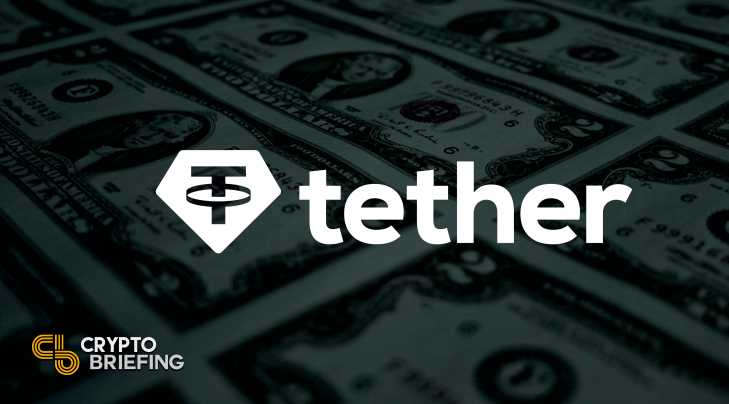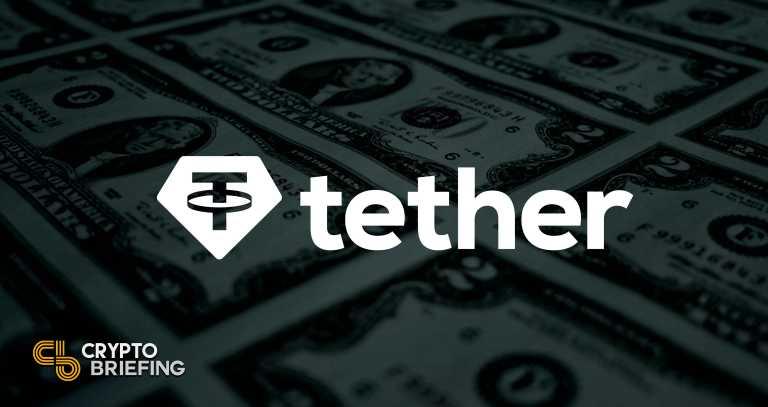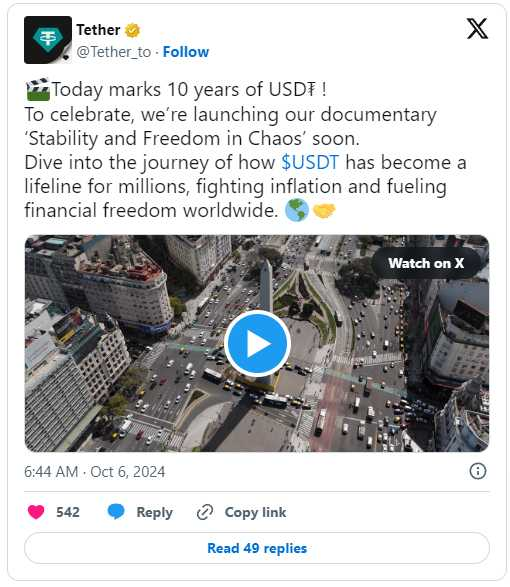Key Takeaways
- USDT dominates Brazil's crypto market with 90% of daily transactions.
- Tether's USDT ranks as the top stablecoin with a $120 billion market cap.
Ten years of bulls and bears, Tether has grown as one of the key players in the crypto industry. The issuer of the world’s largest stablecoin today commemorates its 10th anniversary with the release of ‘Stability and Freedom in Chaos,’ a documentary about USDT and its role in combating inflation.
The documentary’s trailer features interviews with users from inflation-stricken countries like Turkey, Brazil, and Argentina, where stablecoin adoption has surged in recent years. USDT, with a market capitalization of $120 billion, is the largest stablecoin and the third-largest crypto asset, after Bitcoin and Ethereum.
An April report from Kaiko reveals that Turkey’s inflationary pressures have been the driving force behind the increasing use of stablecoins over the past year. With over $22 billion traded on Binance in 2024, USDT-TRY was the most popular trading pair.
In Brazil, USDT accounted for 80% of the total crypto transaction volume in 2023, amounting to approximately $54 billion. Brazilians use USDT in daily transactions due to its stability, Chainalysis reported.
Argentina has seen even greater demand for USDT, primarily due to ongoing currency devaluation and high inflation rates. Many Argentinians convert their salaries directly into USDT or similar stablecoins as a hedge against inflation.
Tether enters the next decade
Launched on October 6, 2014, by Brock Pierce, Reeve Collins, and Craig Sellars, Tether initially operated on the OmniLayer platform on the Bitcoin protocol. It has since expanded to multiple blockchains including Ethereum and Tron.
Tether now enters the next decade with its core mission to continue to empower individuals, communities, and nations through technology and financial tools.
“Our focus has always been (and will always be) the last mile. Rich people have already tens of ways to transact and store wealth. We build financial tech for the people left behind,” said Tether CEO Paolo Ardoino.
“From financial tools (stablecoins) to tele-communications, from Artificial Intelligence to unstoppable education and energy, we believe in the importance of empowering people, communities, cities and entire countries,” Ardoino stated.
Tether to unveil new tech solution for European market amid Coinbase delisting rumors
Tether commends EU regulators for their efforts to establish a structured framework for stablecoins through MiCA.

Key Takeaways
- Tether is developing a technology solution tailored for the European market.
- The new tech aims to address challenges posed by the MiCA regulatory framework.
Tether is set to introduce a new technology solution specifically designed for the European market in a bid to adapt to the evolving regulatory landscape in the region. The plan was revealed amid rumors of USDT’s potential delisting from Coinbase in Europe.
“As we have consistently expressed, some aspects of MiCA make the operation of EU-licensed stablecoins more complex and potentially introduce new risks to both local banking infrastructure and stablecoins themselves,” Tether told Crypto Briefing on Friday.
“Tether is developing a technology-based solution, which we will unveil in due course and will be tailor-made to serve the necessities of the European market. We’re very excited about our upcoming product strategy,” the company added.
Coinbase has set December 30, 2024 as the deadline for stablecoin compliance in the EU. After the designated date, the exchange will delist non-compliant stablecoins in the European Economic Area (EEA). The change will not affect other regions.
The decision is part of Coinbase’s ongoing effort to comply with MiCA regulations. Before Coinbase, a number of crypto exchanges such as OKX, Bitstamp and Uphold, ended services for non-compliant stablecoins in the EU ahead of MiCA’s full implementation.
Tether CEO Paolo Ardoino previously explained that the company still discussed with the regulators about concerns regarding the stringent cash reserve mandates set forth by the MiCA regulations.
Ardoino warned that the strict requirements could pose systemic risks to both banks and digital assets, making them vulnerable to mass withdrawal, similar to the case of Silicon Valley Bank.
While Tether said certain aspects of MiCA may pose challenges for EU-licensed stablecoins, the firm praised EU regulators for creating a structured regulatory environment, which is crucial for the sector’s growth.
“In Europe, the use cases for stablecoins are very different from the ones in emerging markets and developing countries where USDT is extremely popular,” Tether stated. “The economy in Europe is stable and very structured. Moreover the regulatory landscape is evolving with the introduction of MiCA. Tether commends EU regulators for their efforts in establishing a structured framework, as it plays a key role in fostering growth within the sector.”





























